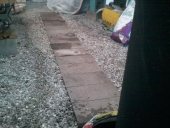posted 11 years ago
All the above are good reasons to consider.
I'd go with pavers (or at least a scored pour) before I'd do a solid cap, in case you need to get in again later to adjust something.
With 2 to 3 inches of dry cob, you are probably safe from collapse - if that's also at least 3-4" on all sides. But I think a 2" concrete paver that extends past the pipe would do more to protect against accidental collapse than the gravel (e.g. someone puts a ladder foot down there).
If the gravel is the drainage base for your greenhouse, the cob will likely stay damp, therefore it's softer (cob does not 'cure' in damp conditions, as it is a purely physical drying set, not a chemical set).
It will remain somewhat soft mud. It does provide some lateral pressure to help support the sides of the pipe, but it's worth your while to make sure that tools, ladders, feet, and other point-loads can't get to the pipe to deform it. And to be able to pull things up and inspect if you think this has in fact happened.
Best of luck, and thanks for posting the project updates! I hope things are working well for you now.
Yours,
Erica W







